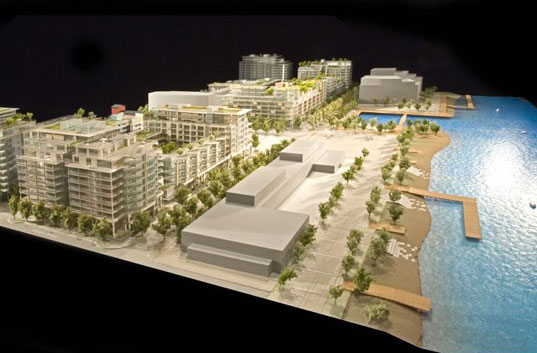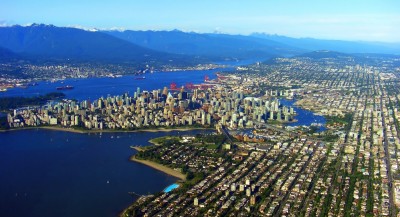 Vancouver’s vision for its Olympic village looks dazzling from afar, like the city itself. Up close the details get hairier.Photo: ecstaticistThe city of Vancouver, British Columbia, has a lot to brag about. It’s got an enviable location, wedged between the Strait of Georgia and the snow-capped Coast Mountains. It’s a perennial winner of “most livable cities” rankings, thanks in part to its parks, arts, and the Canadian social safety net. Its youthful mayor, Gregor Robertson, talks up the city as the greenest in North America and has laid out a plan to make it the most sustainable city in the world.
Vancouver’s vision for its Olympic village looks dazzling from afar, like the city itself. Up close the details get hairier.Photo: ecstaticistThe city of Vancouver, British Columbia, has a lot to brag about. It’s got an enviable location, wedged between the Strait of Georgia and the snow-capped Coast Mountains. It’s a perennial winner of “most livable cities” rankings, thanks in part to its parks, arts, and the Canadian social safety net. Its youthful mayor, Gregor Robertson, talks up the city as the greenest in North America and has laid out a plan to make it the most sustainable city in the world.
So you better believe the city will be showing off its environmental credentials when it hosts the 2010 Winter Olympics next February. “Greening” the Olympics has become an expectation, after all (see Turin’s recycling programs and Beijing’s attempt at air quality improvements). As the largest city ever to host the Winter Games, Vancouver intends to make sustainability central to its Olympic legacy.
The centerpiece of those efforts will be the athletes’ village at Southeast False Creek, an 80-acre rehabbed brownfield that lies across a “false creek” from the downtown peninsula. There, a $1 billion city-within-a-city is rising in preparation for next year’s Olympic and Paralympic athletes. For years the city eyed the site as a place to try out a new kind of sustainable neighborhood. Winning the Olympic bid in 2003 provided the impetus.
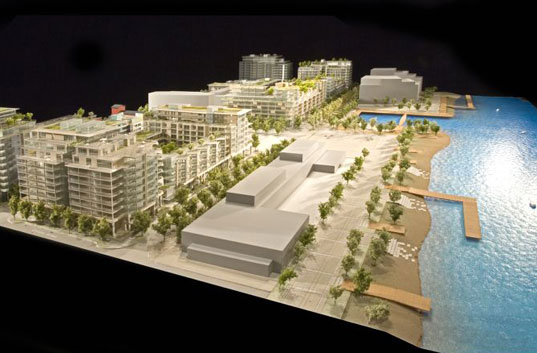 Artist’s rendering of the Olympic village. Watch a slide show about the project.The development is distinctively European in its design, an odd influence in a city that can already feel more Asian than North American (See a slide show about the project.) Elsewhere in the city, the “Vancouverist” architectural style highlights slender towers that provide high density while preserving open view corridors (to take in the surrounding water and mountains). But at Southeast False Creek, short, squat buildings push to the edge of narrow streets and courtyards, evoking Amsterdam more than Singapore. Plazas and inner courtyards emphasize shared space, and the streetscape design draws on the Dutch concept of woonerf, a combined sidewalk/street that uses paving and landscaping to encourage walkers, cyclists, slow-moving cars, and children at play to make room for each other.
Artist’s rendering of the Olympic village. Watch a slide show about the project.The development is distinctively European in its design, an odd influence in a city that can already feel more Asian than North American (See a slide show about the project.) Elsewhere in the city, the “Vancouverist” architectural style highlights slender towers that provide high density while preserving open view corridors (to take in the surrounding water and mountains). But at Southeast False Creek, short, squat buildings push to the edge of narrow streets and courtyards, evoking Amsterdam more than Singapore. Plazas and inner courtyards emphasize shared space, and the streetscape design draws on the Dutch concept of woonerf, a combined sidewalk/street that uses paving and landscaping to encourage walkers, cyclists, slow-moving cars, and children at play to make room for each other.
“You’re creating a better community feel because you have more eyes on the street, more people with contact with the street level, and less of that height that keeps people apart from each other,” said Robin Petri, the city’s project engineering manager.
Southeast False Creek’s 16 buildings will include market-rate and affordable housing, a senior housing center, retail shops, a grocery store, a pharmacy, and eventually an elementary school. There are enough clean energy and conservation features to make the head spin—bioswales and wetlands to treat runoff water, rainwater cisterns that irrigate green roofs and flush gray-water toilets, solar-powered trash compactors, heat drawn from sewage pipes, a radiant heating and cooling system.
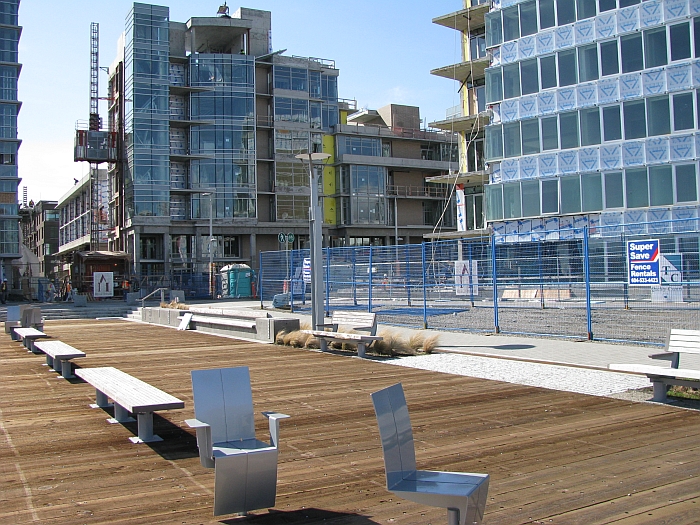 The development’s layout emphasizes communal space, as with this waterfront boardwalk, a nod to one of the site’s past uses as a shipyard.Photo: Jonathan HiskesIf it sounds a lot like every other Cool Green Building Project, fair enough. The village is LEED-ey, with expectations that 15 of the buildings will be certified gold and one platinum, under the Leadership in Energy and Environmental Design (LEED) standard. The development is also participating in the pilot LEED neighborhood program. But it’s not the highest-rated LEED project—that distinction currently goes to Dockside Green in nearby Victoria, B.C.
The development’s layout emphasizes communal space, as with this waterfront boardwalk, a nod to one of the site’s past uses as a shipyard.Photo: Jonathan HiskesIf it sounds a lot like every other Cool Green Building Project, fair enough. The village is LEED-ey, with expectations that 15 of the buildings will be certified gold and one platinum, under the Leadership in Energy and Environmental Design (LEED) standard. The development is also participating in the pilot LEED neighborhood program. But it’s not the highest-rated LEED project—that distinction currently goes to Dockside Green in nearby Victoria, B.C.
Southeast False Creek is notable more for its size—planners predict an eventual population of more than 10,000—and for the international attention it will receive in the Olympic spotlight.
Design manager Roger Bayley summarized the hope that the village’s influence in architecture and planning circles will stretch far beyond Vancouver: “I personally believe it could have a very significant influence,” he said. “It’s being constructed on a scale and in a timeframe that is literally unheard of, except maybe in China. And it’s embracing a whole series of innovations that I think many people … will be extraordinarily impressed with.”
That’s one potential legacy. There’s another possibility. Seven months before opening ceremonies, a string of problems nearly as numerous as the clean-tech features threatens to eclipse the project’s sustainability goals.
Overshadowing and complicating every other trouble is a financing mess rooted in last fall’s credit crisis and mired in the real estate slump. The project was to be the first Olympic village that was largely funded by private sources and sold as market housing (they are typically built by governments and used afterward as low-income or senior housing). The city, which owns the land, was reportedly glad to avoid the responsibility of supervising construction and financing, while still standing to turn a profit on the project. It ceded much of that work to the developer Millennium Development Corporation. But Millenium’s funding mechanism collapsed last October when the New York hedge fund Fortress Investment Group pulled out of the project, leaving the city holding the tab. The city council made arrangements, first in secret and then publicly, to shore up the project with tax money—now figured at $450 million Canadian ($403 million U.S.). City leaders hope they can recover the cost when the units are sold to private buyers for use after the Olympics. Of course, that depends on the real estate market.
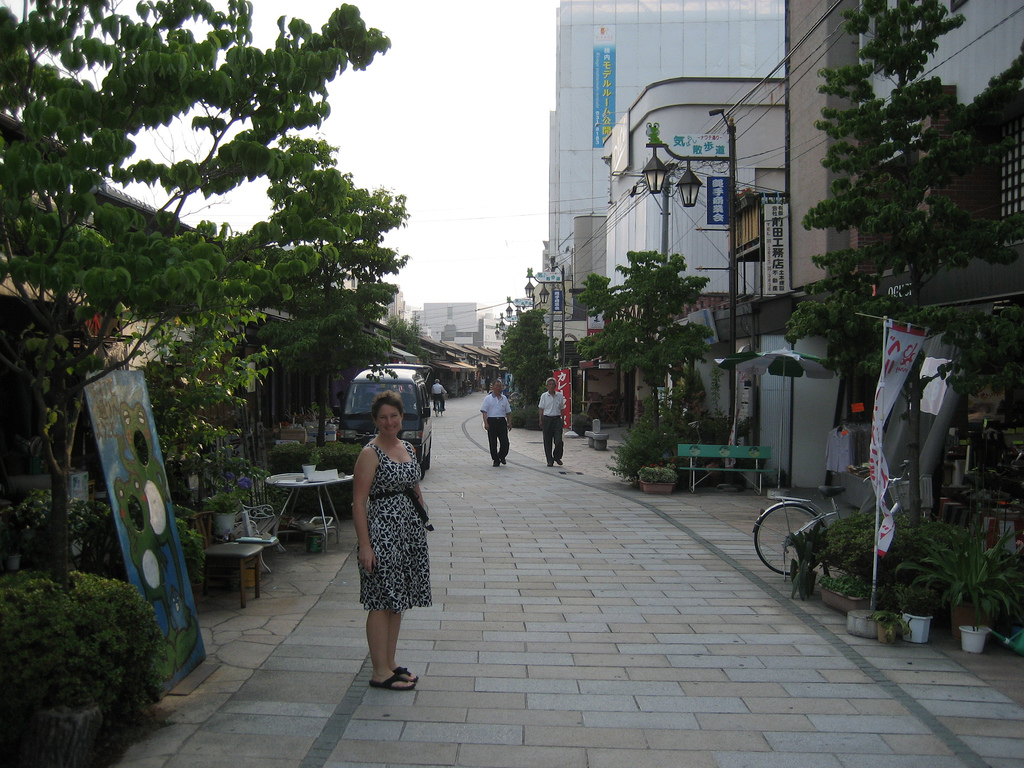 A woonerf, or shared-used street, in Matsumoto, Japan. Southeast False Creek will employ similar narrow, winding byways. Photo: Cheryl & RichOther setbacks: Construction lags behind schedule, pressuring workers to meet a Nov. 1 deadline, when the development company hands control of 1,100 units to Olympic organizers. In late June, reports arose of a possible mold problem because of improper pipe installation. A goal that vegetation would cover 50 percent of the project’s roof space has been scrapped, reportedly because insurers worried about flooding. [Correction: Petri said the project is on track to meet this target.]
A woonerf, or shared-used street, in Matsumoto, Japan. Southeast False Creek will employ similar narrow, winding byways. Photo: Cheryl & RichOther setbacks: Construction lags behind schedule, pressuring workers to meet a Nov. 1 deadline, when the development company hands control of 1,100 units to Olympic organizers. In late June, reports arose of a possible mold problem because of improper pipe installation. A goal that vegetation would cover 50 percent of the project’s roof space has been scrapped, reportedly because insurers worried about flooding. [Correction: Petri said the project is on track to meet this target.]
The city also scaled back the amount of low-income and middle-income housing it originally pledged to include. It will now subsidize 252 low-income units, a target that has nearly doubled in cost, from $65 million to $110 million, The Vancouver Sun reports. The city has yet to determine who will qualify and how to select tenants for the subsidized dwellings, Petri said.
British Columbia’s anti-Olympic protestors have also focused some of their disapproval on the development, even though Olympic housing will occupy only 50 of Southeast False Creek’s 80 acres. Much of the development will be built after the games, and of course the whole village will last far longer than its use for the games. Still, planners have battled the perception that the short-term event influenced the city’s long-term plan.
“This isn’t really about the Olympics,” said Petri. “The Olympics just provided us with a fixed timeline and an opportunity to give it lots of attention. But this was planned way before the Olympics. Whether someone’s excited about the Olympics or not is really independent from how they feel about the site.”
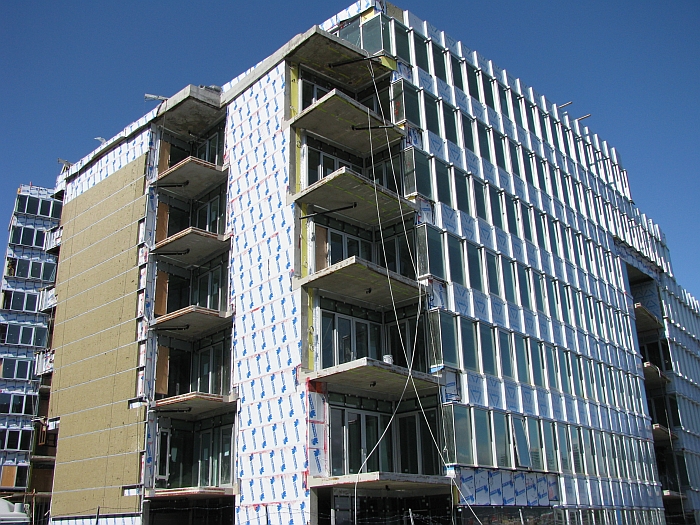 The project’s blocky buildings achieve the same density as many of the city’s tower housing developments, according to the city’s project engineering manager, Robin Petri.Photo: Jonathan HiskesIt will be interesting to see which storylines prevail when the international media trains its eye on Vancouver next winter—the financial mess, the shrinking social-housing target, the clean-energy and water-use technologies, the attempt to build not just green buildings but an entire sustainable neighborhood, or something else altogether. Organizers have begun releasing an elaborate online book on their vision for the site, in monthly segments, to help along those glowing profiles. (To be fair, the publication includes some good information, not just PR.)
The project’s blocky buildings achieve the same density as many of the city’s tower housing developments, according to the city’s project engineering manager, Robin Petri.Photo: Jonathan HiskesIt will be interesting to see which storylines prevail when the international media trains its eye on Vancouver next winter—the financial mess, the shrinking social-housing target, the clean-energy and water-use technologies, the attempt to build not just green buildings but an entire sustainable neighborhood, or something else altogether. Organizers have begun releasing an elaborate online book on their vision for the site, in monthly segments, to help along those glowing profiles. (To be fair, the publication includes some good information, not just PR.)
Assessing the project’s long-term influence will be more difficult. Locally, it may wear down some of the resistance that comes with trying to build things differently. Bayley, the lead designer, spoke this spring about seeking permits to use harvested rainwater to flush toilets.
“You’d think that would be a simple thing to do, but persuading municipal authorities was not as simple as we’d hoped,” he said. “We ended up putting signs on the toilet saying ‘do not drink this water.’ Then they wanted it translated into dog and cat.”
Petri added later, “But now they’ve approved it, and the next attempt at this won’t be as new to them.” She said the project would help permitters, contractors, engineers, landscape architects, and others who work on it become comfortable with high-efficiency techniques. From there, she hopes, they might spread throughout the building and planning trades. In other words, despite all the attention that comes with being novel, the real goal of Southeast False Creek is to help such projects become normal.
Watch a slide show about Vancouver’s Olympic village at Southeast False Creek:

